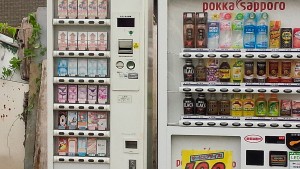Yesterday, on TV, was one of the most disturbing, yet adorable things, I’ve ever seen on television. It involved 80 young women in miniskirts and lots of chubby nerds waving glow sticks in the rain.
Before I get to that, though, I need to reminisce. One of the things I remember from when we still lived in Colorado was a short lived 1980 TV show featuring the Japanese pop duo Pink Lady. Mostly I remember them being both really cute and really bad actresses and that they sang “Knock on Wood”. I’d forgotten that Jeff Altman had been on the show and that they’d spent time in bikinis–Pink Lady, not Jeff Altman–which is something I’d normally remember. They also had a single reach 37 on the Billboard Top 40. The show was terrible and lasted only five or six episodes.
I didn’t realize until I got to japan how popular Pink Lady had been. Although they were already in their decline when they came to the USA–they broke up in 1981–when I got to Japan in 1996, even young people could still perform Pink Lady dances. (Their synchronized dances are one part aerobics and one part martial arts kata.) Here’s UFO, one of their biggest hits. You don’t need to understand Japanese, just watch the kata, er, dance. (Here’s another one from their peak era, 1977.)
One of the things foreigners don’t get about Japan is how intense the Japanese are about celebrities (called talents even if they have none). This is especially true of any groups that survive more than two years. Any group that does that begins to dominate television, including music shows and game shows. One quirk of Japanese TV is that most game shows are populated with celebrities and not ordinary people. There are lots of complicated reasons for this but that’s another post.
Very few groups, though have risen to the level of AKB48. They started out as a few young ladies performing in a small theater in Akihabara, the tech/geek district of Tokyo. Through clever marketing that played up the Lolita angle (they had a video that basically promoted “paid dates” and one that featured a soft core lesbian orgy/slumber party. Not safe for work.) They quickly grew to around 80 members and, if their expansion continues on pace, they will eventually rule Japan and the rest of the world.
One of the ways they stay fresh is to constantly rotate their lead 16 (called the Senbatsu) with members from the lower ranked groups. (Their structure is way too complicated to explain. Just think of it in terms of first string, second string, minor leagues, injured reserve.) Another trick is to involve the fans and let them vote on the order the girls should be in.
This is where the disturbing thing on television comes in. Once a year AKB48 take over a stadium and hold the Senbatsu Sousenkyou general election, which amounts to a political rally where fans can rank the girls. The girls are then forced to sit on stage until the results are announced whilst a stadium full of 70,000 chubby 20-something nerds ogle them and vote on them. The entire spectacle looks disturbingly like the Nuremberg Rally. (Here’s last years Sousenkyou; here’s the Nuremberg Rally.)
As their names are announced, each girl moves from a waiting area to her proper place on stage. The higher ranked girls get a chance to make a short speech. (Note: although they are part of the same group, the girls all have different managing agencies and are desperate to get a high rank and more exposure.) The winner becomes the official leader of AKB48 and gets a lot more air time than the others. This year’s winner was the annoyingly cute Mayu Watanabe (nickname Mayuyu). She was even dressed up like a queen (scroll down a bit) and given the chance to make a speech.
She said basically “Thanks to all the other girls, who are all still my friends and I don’t think less of them. I promise to do a good job, even though it’s a difficult job. Thanks to all of, you, my fans, who made this day necessary. Now KILL ALL HUMANS! KILL ALL HUMANS! KILL THEM ALL!” Well, that last part might be a bit of an exaggeration, but I have no doubt that if Mayu Watanabe ordered the fans to seize the parliament and throw out Prime Minister Abe they would.
A Mayuyu administration might actually be worth considering. Maybe they really will rule the world.



